This is Naked Capitalism fundraising week. 1031 donors have already invested in our efforts to combat corruption and predatory conduct, particularly in financial realm. Please join us and participate via our Tip Jar, which shows how to give via check, credit card, debit card, or PayPal. Read about why we’re doing this fundraiser, what we’ve accomplished in the last year, and our fifth goal, more original reporting.
Yves here. van Onselen is on a roll. This is an important bit of analysis, and is consistent with my views, which my economist interlocutors agree with: that the oft-made argument that demographics, by which they really mean population growth, is economic destiny is largely bunk. I lived in Oz in 2002 to 2004 when Australia had had the best run of economic growth of advanced economies despite (or perhaps due to) being on the sidelines in the Internet boom. And its population growth had been modest over that time frame.
By Leith van Onselen, an economist who has previously worked at the Australian Treasury, Victorian Treasury, and Goldman Sachs. Originally published at MacroBusiness
This site has gone to considerable effort to demonstrate why high population growth (immigration), as advocated by Australia’s major political parties, is very likely lowering the living standards of existing residents.
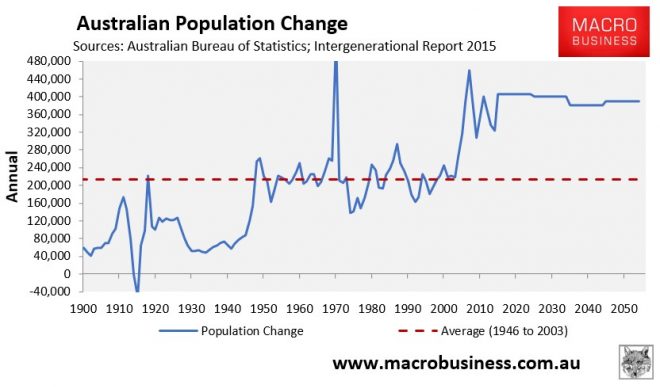
Since 2003, Australia’s population has grown by a whopping 22% – way faster than other advanced English-speaking nations and 2.5 times the OECD average:
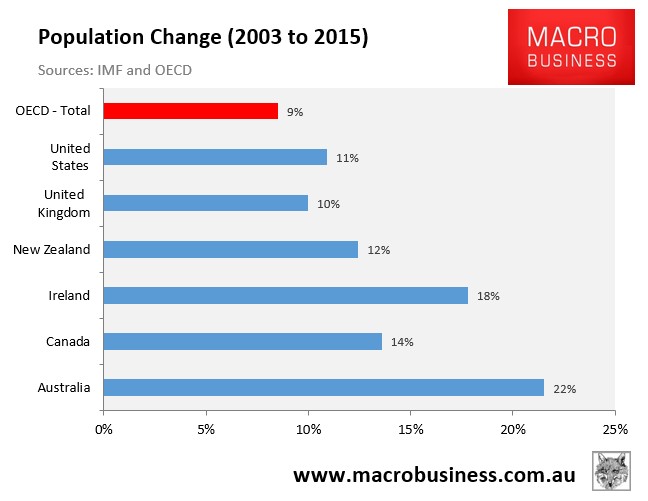
Since the immigration flood gates were jammed open in 2003, Australia’s per capita GDP and disposable income has grown at an anaemic rate compared to the previous corresponding 12-year periods (see below charts).
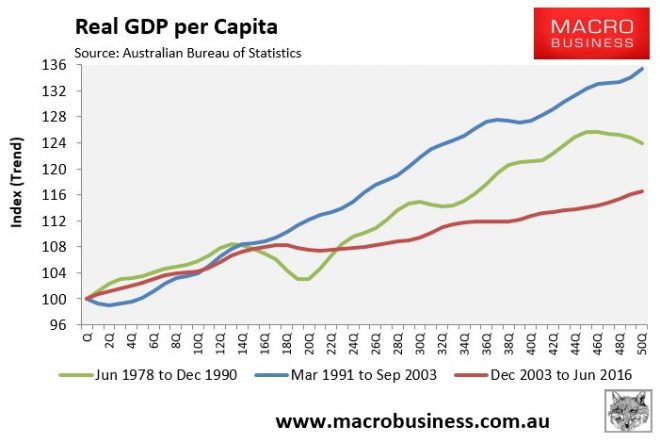
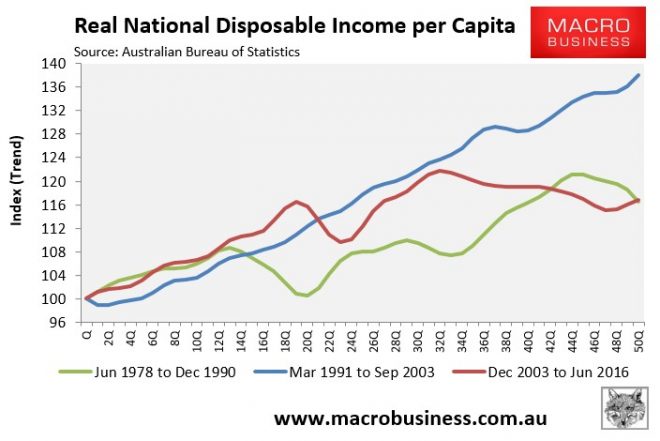
And this comes despite growth in the terms-of-trade being most favourable across the most recent 12-year period (see next chart).
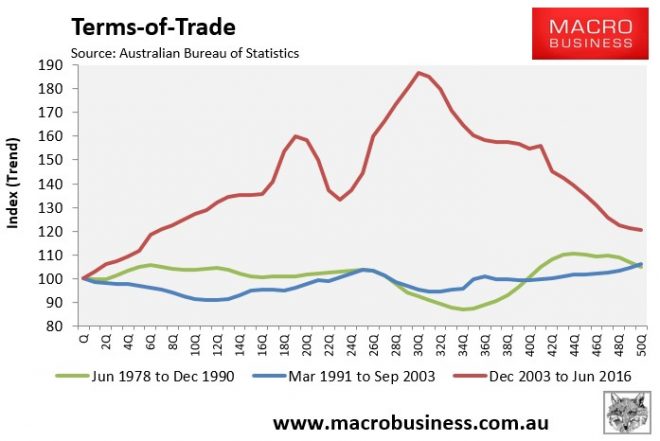
When viewed alongside qualitative measures like traffic congestion and housing affordability, which have clearly worsened as the population has exploded, there is a strong case to be made that Australia’s high population growth strategy is very likely lowering individual living standards.
Yesterday, I spent many hours crunching OECD macroeconomic data to determine whether there is a link between population growth and economic prosperity.
The first chart below is a scatter chart plotting the change in per capita real GDP against population over the years 2000 to 2015 across the 35 OECD member nations (Australia is shown in red):
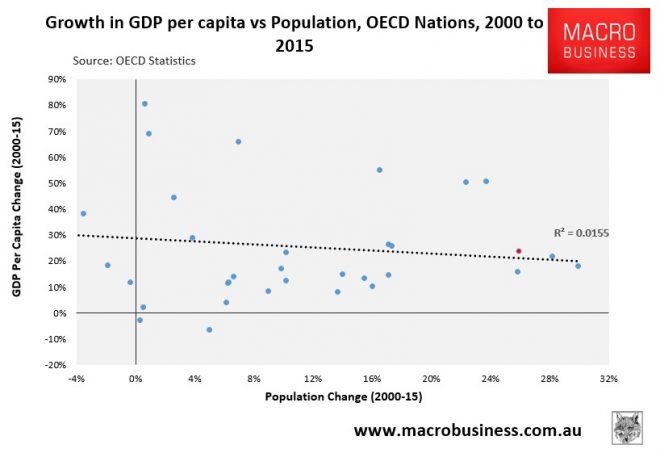
As you can see, there is no statistically significant relationship between the growth in the population and per capita real GDP across OECD member nations.
The next charts delve deeper and plot the change in population against measures of productivity. As explainedby the Productivity Commission (PC):
Productivity growth is a key source of long-term economic growth, business competitiveness and real per capita income growth. It is an important determinant of a country’s living standards and wellbeing.
There are two broad measures of productivity:
Labour productivity (output produced per unit of labour input) measures efficiency in the use of labour. Growth of labour productivity is the growth of output over and above the growth of labour input — it not only measures change in the efficiency of labour but also captures the value added from growth in capital (and more advanced technology intrinsic in the new investment) that supports increased output without increasing labour.
Multifactor productivity (output produced per unit of combined inputs of labour and capital) is the measure that comes closest to the underlying concept of productivity — efficiency of producers in producing output using both labour and capital. Growth of multifactor productivity is the growth of output over and above the growth of combined labour and capital.
The first chart shows the relationship between population growth and labour productivity growth across the 35 OECD member nations over the period 2000 to 2015 (Australia shown in red):
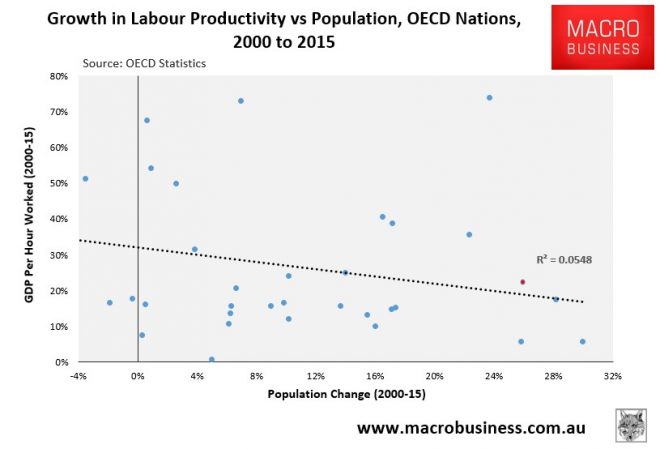
The second chart shows the relationship between population growth and multifactor productivity growth across 20 OECD member nations (where data is available) over the period 2000 to 2014 (Australia shown in red):
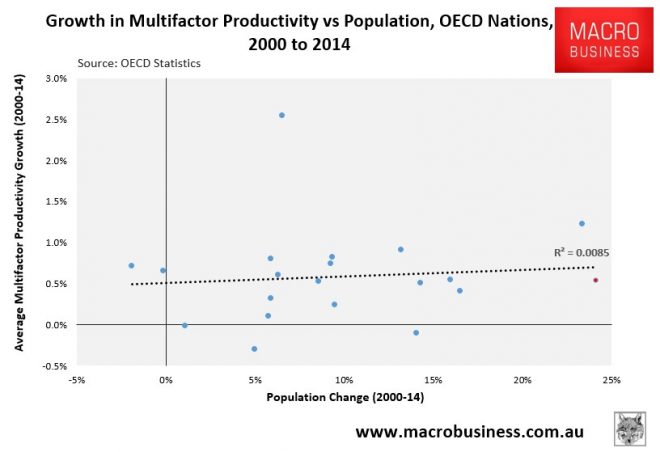
In both cases, there is no statistically significant relationship between population growth and productivity across OECD member nations.
Further, despite experiencing some of the highest population growth in the OECD, Australia’s productivity growth has been lackluster by comparison. While this does not by itself suggest that Australia’s high immigration program has lowered productivity, it is nigh impossible to argue that it has raised it either.
Ultimately, the only real economic “benefit” that comes from running a high immigration program is via an improvement in Australia’s population pyramid as younger workers lower the average age profile and increase the ratio of working aged to non-working aged. As explained by the PC:
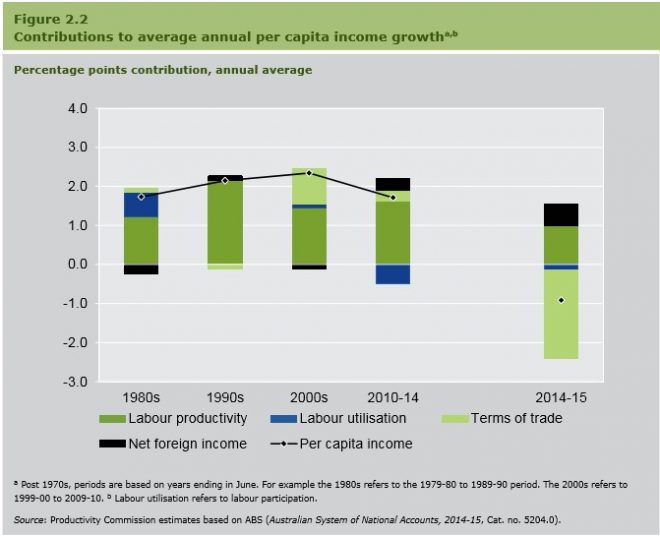
Growth in the population can increase the size of the economy but does not, in itself, increase output or income per capita. Growth of per capita income is determined by changes in participation (referred to as ‘labour utilisation’ in figure 2.2), labour productivity, the terms of trade and in net foreign income…
However, any benefit to labour utilisation is only transitory: as the migrants grow old they too add to the number of retired people, thus requiring ever more immigration and an ever bigger population to keep the age profile stable (classic Ponzi Demography).
Against these transitory benefits are the costs associated with pressures on infrastructure, housing , the environment, and in Australia’s case, the dilution of its fixed mineral endowment, which is a key driver of our wealth and living standards.
In short, the broad macroeconomic data – both domestic and international – does not support the assertion that Australia needs to run a high immigration program in order to drive the economy and increase living standards. In fact, given the significant qualitative costs – for example, the degradation of the environment, the depreciation of natural resources and decline in individuals’ quality of life – there is significant cause to dial Australia’s immigration program right back.


As painful as it may be to hear, no one who matters (corporations, government, the UN, etc.) cares very much about per capita GDP. Growth is driven primarily by population. A minimum income lets people buy Coca Cola and a cheap phone. Given the massive transfer of wealth to the top 1%, the luxury brands are doing better than ever as well despite this lack of GDP per capital growth.
More people makes the pie higher (to paraphrase that great 20th Century scholar Dan Quayle).
Its amazing how often we here in the media about ‘GNP growth’, but we almost never hear about ‘GNP per capita’ growth, which is the only measurement of any real relevance to nearly all citizens.
If the OverClass takes most of the GNP growth, and the Upper Class takes the rest of the GNP growth, leaving no benefits of that growth for the majority to enjoy; then the concept of “rising GNP per capita” is a mere statistical artifact having zero relevance to the people who caused all the rising GNP growth and receive none of it.
I like Lambert Strether’s suggestion of considering the “next ten per cent” as the social class of high level servants and such who directly support and enable the OverClass to exist and to rule. I will suggest some slightly different wording in the hopes that my wording might be more poetic and hence more memorable and therefor more useful.
I would speak of the Top One Per Cent, the Next Nine Per Cent, and the Lower Ninety Per Cent at the bottom. One – Nine – Ninety. The “Nine” being the Tin Horn Meritocracy which are the intellectual backbone of Clinton’s brainwar machine.
I think just describing them as the ‘nobles, the knights and the peasants’ is close enough. All feudal societies have similar structures.
The Tcherneva charts shows that this is exactly what has happened in recent years (which you of course already know):
http://billmoyers.com/2014/09/29/smart-charts-economic-recovery-1-percent/
This is quite an Australian almost unique problem. But very interesting indeed. It strikes me the comparisons between population growth and productivity. Why exactly? Do we really understand what does “productivity” mean. The fact that economists focus so much on “productivity” always strikes me. Productivity is an important target for a particular company, but in aggregate macro economics, it does not have a meaning that human brains can really understand. It is a by-product not a target.
The fact that economists focus so much on “productivity” always strikes me. — It’s simple: productivity is all about the ‘bezzle – the 99% continually get squeezed to produce more and more, but instead of sharing in the fruits, their employers simply cream off the gains. The employers and rentier classes being the ones “most economists” serve. Make sense now?
The overall conclusion is that economists have little to no clue about how to generate economic growth in the absence of population growth. This is partly a politically conveniently ignored deficit since any politician wants to claim economic growth, but if all that increase is in line with population growth, then the standard of living hasn’t changed and with a concurrent increase in income inequality, may have actually declined. What we end up with a paradigm where useless actions intended to drive economic growth are masked by underlying population growth and the ruling class declares, mission accomplished.
Japan is the poster child for this deficiency in economic theory.
>partly a politically conveniently ignored deficit
Ah it’s simple, just blather on about how Louis XIV would be so envious of your smart phone.
>have little to no clue about how to generate economic growth
This is neither a bug or a feature of the profession – it is completely irrelevant. They need to generate employment for themselves, the rest is just fog.
The equation population growth is economic growth is an unexamined presumption of the dismal science. In an agricultural economy the two factors would correlate since more field hands = more food production = fewer people starving to death. So population follows rather than causes growth.
Outside of that, economic growth depends on consumers with resources for demands outside mere survival. Opening the borders to millions whose only resource is their ability to work doesn’t do it. So immigration has costs, which are borne by the majority, and if it has any benefits, they’re taken by the elite.
The qualitative costs the author mentions are from increased social friction and the loss of social amenities. Both of which can only be costed at a remove, and so are rarely data pointed into analysis.
Might have missed this, but I think the author would have addressed the question more thoroughly if he had run several different time periods, not just one in which the middle years feature the near collapse of the world economy.
My thought as well. Living in the age of austerity and rapid rise of inequality is going to skew the results.
That said, if there is no relationship between population growth and productivity growth, then there is no need to reduce immigration either.
>then there is no need to reduce
I’ve tried that with the Lump of Labor Theory Fallacy, pointing out that we therefore could work less as well as more hours but it surprisingly failed to get me one of those cushy econ gigs.
Since these recent years are the ones in which Aus really increased the level of immigration, he would have had little to compare to. That said, if the Aus “recovery” has been as great as that in the US, including the recovery years after the trough will have balanced things out.
The data do seem to show something but…
…doesn’t this imply that an ageing economy with an unaccounted-for social security timebomb shouldn’t let young people in (because they earn less and would lower GDP per capita) to rebalance the age pyramid? That is probably wrong so therefore the theory is probably wrong.
Reductio ad absurdum. Probably.
I think he was just acknowledging that if you are going to treat your social safety net as a Ponzi scheme, then you will get the consequences. It delays the day of reckoning but compounds the misery. So better deal with it properly now.
I dislike the graphical presentation of the data, with its spuriously neutral numbers of quarters and not a hint of the actual years involved. As far as I can see, the slopes of GDP and disposable income curves were roughly comparable to previous periods until the financial crisis. An “analysis” that leaves out essential historical conditions and tries to pin everything on a preselected cause is begging the question with a vengeance, not to be taken seriously. That’s too bad; he might have had something interesting, but he didn’t take it seriously enough himself to go into it.
I am impressed. No ‘scapegoating immigrants’ talk, just rational analysis. Kudos.
A couple of other points about a young population pyramid being somehow good. Yes, if the age distribution is skewed low, there will indeed be more workers than retirees – but more children per worker! The number of dependents per worker is not really improved by a young age distribution. Also, a growing population requires massive ongoing capital investments just to stay even, while a stable or slowly growing population doesn’t – in that case, even modest capital investment can result in improvement. So GDP/capita can be misleading, because a rapidly growing population requires a lot of that just to stay even, like running on a treadmill. Additionally, as population density rises the cost of land and water etc. eventually goes up, the economic activity appears to increase, but a gallon of fresh water has the same utility regardless of whether it costs one cent or one dollar.
Still, these are quibbles. Kudos.
Listening to a well respected Wall Street financial analyst a while ago had a moment of pause when he talked about how great America’s expected population growth was. I knew it was an analysis that benefitted the top and nothing else. Bad for the environment, more competition for fewer jobs, downward wage pressure, and even greater upward pressure on housing costs.
I am neither an economist or an analyst. Nor am I anti immigration. But any one with any common sense has to know that there is a very small range of population growth which benefits all or even most. And that number is fluid depending on the vibrancy of the total economy.
But ultimately it’s the sustaining of growth that is prioritized over the sustaining of people, as if the planet were a factory. The world is still in the thrall of Taylorism and Fordism, which had the effect of dehumanizing people, thought of as interchangeable parts. The standard of living of a machine part is not something to be prioritized. So of course there’s a mindset that always thinks you need as many spare parts around as necessary to keep the factory flowing smoothly.
But, you might say, we are not just parts but consumers. Consumption helps growth.
Well, until it doesn’t. Consumption has its limits.
Debt as growth has its limits.
Population growth has its limits.
Growth has its limits which is why sustaining a population would eventually come down distribution of resources.
But now we’re back to what I said at the beginning, sustaining a population isn’t the priority, sustaining growth is.
So who are we trying to sustain economic growth for when we’re just really still thought of as replaceable parts in the world factory? Parts only important as long as they are “productive” or “efficient?”
And you can’t really say the tech or information economy/industries changed that because they are an outgrowth of the priorities of the Taylorism of the industrial age and still operate under the same assumptions.
So who are we trying to sustain economic growth for?
Maybe two-tier economies would work. Industrial and social. Industrial being capitalist and competitive could really be self sufficient because not only can they maximize productivity and efficiency with robots, they can use robots to make consumer robots and keep their ideal “economy” in perpetuity no matter how pointless. The other economy which for all earthly purposes is the only possible economy, will function benefit people and the planet, using its own creativity. There really doesn’t seem to be any way to integrate the two because they are like oil and water.
The idea of open immigration is now so politically charged, it’s become like religion, abortion—you can’t have a calm public discourse about it.
And IMO, rather having the issue dealt with head-on, it’ll simmer until the whole mess blows up in the polity.
America will be ok, it’s Europe going ultra-right that I’m more worried about.
Talking of which, you might like to see some of the UK tabloid recent offerings.
https://politicalscrapbook.net/2016/10/mail-and-express-remain-voters-are-unpatriotic-traitors-who-need-to-be-silenced/
GDP per capita is not the full story. A fixed population can work more hours to increase its GDP/cap. Only GDP per hour worked captures the real benefit of enhanced productivity to the standard of living. However, simple GDP growth is of benefit to owners of capital. The bigger the economy the larger the profits. Population growth requires expansion of basic infrastructure,schools, housing, roads, parking garages and parking lots, bridges, gas pipes, sewer pipes , water pipes and the electrical grid. This type of basic infrastructure is very expensive compared to deployment of new technologies such as automation. Basic infrastructure deployment is not just expensive but can be very controversial. Authorization for parking expansion by building a small three story garage in my small city has taken years. I agree the full story of population growth is rarely addressed by economists or politicians.
I’m pleased that the author refers to “Ponzi Demography”. Any apparent benefits from population growth are like the transitory benefits of a financial Ponzi scheme. More is always required; the need for more never ends, until more is impossible. In the financial Ponzi scheme, it becomes impossible to add new money to the system. In the demographic Ponzi scheme, resources run out, or the quality of life is ruined by too many people in too little space.
This kind of analysis is a waste of time. Its like driving down the Interstate with a big sheet of cardboard taped to your front windshield and trying to drive by looking in the rearview mirror. What nonsense.
Wowsers. I can see reasoning is not your long suit.
Did you miss that Australia made a big policy change regarding its policy on immigration, and this post analyzes how that worked out?
Logic hint: it’s not driving from the rear view mirror if you look at how changes meant to produce a specific outcome actually worked out. Same approach as clinical trials: you give someone a drug to treat an ailment, then test to see what if anything it did.
We are still running on Adam Smith. Cute idea except that the world is finite.
I give China and India twenty years before their populations crash and each in a war over water, possibly with each other.
Mmmm, irradiated water anyone?
Weathermen declared that the clouds over the city would bring rain, and they did. Maybe more or less than predicted, and not distributed everywhere, but rain had certainly fallen. The weathermen celebrated their prediction.
Three months later clouds arrived again and the weathermen declared there would be rain, and there was. Maybe more or less than predicted, but certainly rain. The weathermen celebrated and declared their theory proven and universally true.
Three months later, clouds rolled in, and the weathermen again declared there would be rain. But instead it snowed.
The weathermen couldn’t agree on what to do. One said that snow was almost like rain, so their theory was still true, even though the snow shut down the city in a way the rain hadn’t. Another said this disproved the idea that rain came from clouds altogether. The third argued that this could only be resolved by the weathermen getting more funding for additional studies.
It’s a good thing these weathermen aren’t economists.
Laugh if you will, but you are probably not English where trains stop running because of leaves on the track and the “wrong kind of snow”! Only in England!
Thank you for publishing this. We can argue over the details but the study shows that there is no obvious massive benefit to immigration from an economic standpoint in a case not unlike the United States, a resource producing country largely…..oil, coal, corn…..all things that do not require much labor. There may be some benefit at the margins but it is not really penicillin and pneumonia where the effect is obvious. Germany would be the next place to study. What I am seeing with family and friends is that the educated German classes are getting out and the published numbers of Germans leaving are quite high and the population is being replaced by the lowest classes of west and central Asia, the Indian subcontinent and Africa. This should lower the average wages and any pressure for unionization with teeth. This might enable German manufacturers to compete with China and India in the future. The US (the preferred destination along with Australia and New Zealand) will benefit from the new immigrants who speak excellent English and are better educated with an Abitur than many others. Of course, I am hearing that in the US our immigration is very restrictive unless you just show up and move in so it is not as easy to get out as it might seem. In terms of quality of life Germany has had a tremendous deterioration. My kid, white and blue eyed and therefore a minority, was constantly attacked in school. In the Gymnasium where there are no recent immigrants since it is 99% native because of the academic demands it goes much better. I think Merkel hopes to get the Muslim generation into the Gymnasium in order to achieve her goal of total integration. It will take quite a bit of work to take an illiterate Afghan or Sudanese and get him through the Abitur.
Hi Felix,
I agree with you that immigration has meant lower wages for the average German, but having taught for three years in a German inner-city school I am very surprised to hear that your child was attacked for being white. Would you mind telling me in which city this happened?
I also think your statistics are misleading: 28% of Germans attend gymnasium, while only 12% of people with an immigration background do. You also suggest that the abitur, which is a high school level qualification, will give German migrants an advantage over other immigrants in Aus, NZ or US. I fail to see how this is possible when these countries demand people with higher degrees, in demand skills or employers. For example, lets look at the US green card priorities:
First Preference: Priority Workers, including aliens with extraordinary abilities, outstanding professors and researchers, and certain multinational executives and managers
Second Preference: Members of professions holding an advanced degree or persons of exceptional ability (including individuals seeking a National Interest Waiver)
Third Preference: Skilled Workers, professionals and other qualified workers
Fourth Preference: Certain special immigrants including those in religious vocations
Fifth Preference: Employment creation immigrants (investors or entrepreneurs)
Your abitur holding high schooler does not make the list. I respectfully suggest that your post relies rather heavily on personal opinion and could do with more substantive facts. I am happy to be proven wrong.